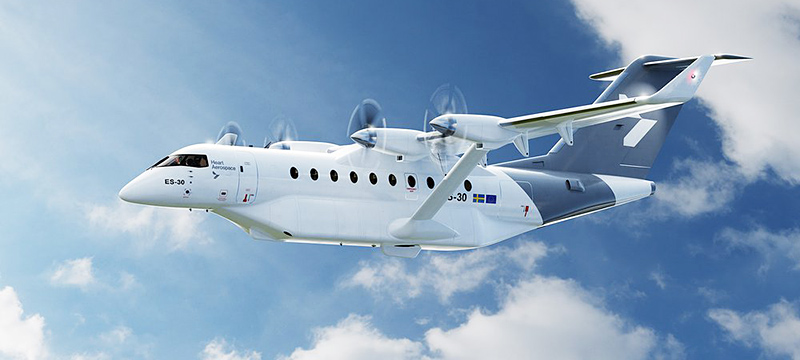

Berg Insight, the world’s leading IoT market research provider, today released new findings about the market for electric aircraft and eVTOLs (passenger vehicles that take off and land vertically).
There are today many large-scale industrial projects in development with the purpose of developing aircraft and eVTOLs based on electric drivetrains. At the same time, the electrification of the aviation industry represents a challenge as the industry is heavily regulated and has a strong commitment to safe operations and redundant systems.
“The market for electric aircraft and eVTOLs will for many years probably be more about high value rather than high volume. The large number of uncertainties going forward open up a lot of possible scenarios in the longer term”, says Henrik Littorin, author of the report.
The flight range is anticipated to be limited in the first decades but due to fast, efficient, sustainable and silent operations they will be able to create new connectivity within large urban areas, between cities, from rural regions to cities and between rural areas.
There are hundreds of eVTOL concepts being developed around the world, both for commercial and private use. Many of them are large vehicles with wingspans of up to 15 metres, something that needs to be considered when developing ground infrastructure as well as working with city planning, passenger processing and safety issues. Examples of eVTOL vendors include Archer, Beta Technologies, Ehang, Eve Air Mobility, Joby Aviation, Lilium, Volocopter, Vertical Aerospace and Wisk.
There are also a number of companies working on electric aircraft and drivetrains, a market where both established aviation companies and start-ups are active. These companies that have completely different backgrounds, address the challenge in different ways, which will result in several possible solutions and design pathways. Examples of electric aircraft developers include Heart Aerospace, Pipistrel, Eviation and Bye Aerospace.
Before 2030, the first piloted eVTOLs will most likely be in commercial operation. Between 2031–2035 the ecosystem and acceptance will develop further and an anticipated 20,000 vehicles will be taken into operation worldwide during the period. From 2036 until 2050 we forecast almost 60,000 deliveries in our mid scenario.
“In our most positive scenario we have come to the conclusion that deliveries could reach up to 150,000 vehicles between 2025–2050. This scenario is based on a favourable regulatory environment where the long-term airspace management has been solved as well as the approval of autonomous flights”, says Mr. Littorin.
There is also a market for private eVTOLs. When assuming favourable conditions, shipments will reach up to 300,000 vehicles during 2025–2050. Most of these will be small two-seaters and the majority of them will be delivered in the later part of the forecast period. These vehicles will all need advanced avionics, connectivity, and avoid and detect technology but at the same time need to be cost-efficient solutions. A tricky combination since the regulatory demands will be very strict.
It will take some years before the first certified commercial aircraft is ready for production. The forecast is based on an aircraft size of 6–19 seats for battery powered aircraft and 19–90 seats for hydrogen (fuel-cell) powered aircraft. This excludes the smallest aircraft types that will probably be used by for example flight schools. Due to the complex certification pathway and the dependence of new ground and charging infrastructure, only a few hundred aircraft are forecasted to be delivered before 2030. In the five-year period between 2031–2035, around 1,000 aircraft are anticipated to be delivered in the mid scenario. Some of the addressable market for electric aircraft is based on the replacement of the current fleet of small aircraft. It will take time to develop production capacity and solve ground infrastructure challenges but with more efficient drivetrains the use case and economics look favourable in the longer term.
Mr. Littorin, says: “We estimate in our mid and high scenarios deliveries of 18,000–25,000 electric aircraft between 2036–2050.”

Electric aircraft and eVTOLs (for commercial and private use) will need to be equipped with advanced connectivity technologies. Cellular connectivity is one of the prominent technologies available to support the use cases in urban areas. The upcoming LDACS (L-band Digital Aeronautical Communications System) standard is a secure, scalable and spectrum efficient terrestrial data link for civil aviation and a cellular broadband system with support for IPv6 standard. Satellite systems can also complement the ground-based architectures, particularly the LEO (Low Earth Orbit) satellite constellations.
Mr. Littorin concludes:
“The number of connected vehicles will take off from 2030 and then increase steadily. We estimate almost 75,000 connected vehicles for passenger use already 2035 and between 350,000–450,000 in 2050. Many of these are smaller and privately owned eVTOLs.”
The post Electric aircraft and eVTOLs will pave the way for a greener future and increased mobility appeared first on IoT Business News.
